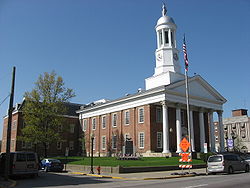Waynesburg, Pennsylvania
| Waynesburg, Pennsylvania | |
|---|---|
| Borough | |

Greene County Courthouse in downtown Waynesburg
|
|
| Etymology: Anthony Wayne | |
 Location of Waynesburg in Greene County |
|
| Coordinates: 39°53′47″N 80°11′11″W / 39.89639°N 80.18639°WCoordinates: 39°53′47″N 80°11′11″W / 39.89639°N 80.18639°W | |
| Country | United States |
| State | Pennsylvania |
| County | Greene |
| Established | 1796 |
| Government | |
| • Mayor | Blair Zimmerman |
| Area | |
| • Total | 0.80 sq mi (2.07 km2) |
| • Land | 0.80 sq mi (2.07 km2) |
| • Water | 0.0 sq mi (0.0 km2) |
| Elevation | 1,034 ft (315 m) |
| Population (2010) | |
| • Total | 4,176 |
| • Density | 5,220/sq mi (2,015.3/km2) |
| Time zone | EST (UTC-4) |
| • Summer (DST) | EDT (UTC-5) |
| Area code(s) | 724 |
| FIPS code | 42-81832 |
| Website | waynesburgboro |
Waynesburg is a borough in and the county seat of Greene County, Pennsylvania, United States, located about 50 miles (80 km) south of Pittsburgh. Its population was 4,176 at the 2010 census.
The region around Waynesburg is underlaid with several layers of coking coal, including the Pittsburgh No. 8 seam, the Waynesburg seam, and the Sewickley (Mapletown) seam. The area is also rich with coalbed methane, which is being developed from the underlying Marcellus Shale, the largest domestic natural gas reserve. Early in the 20th century, four large gas compressing stations and a steam shovel factory were located in Waynesburg.
Waynesburg is named for General "Mad" Anthony Wayne, one of the top lieutenants of George Washington during the Revolutionary War (1776–81). The borough is the location of Waynesburg University and the Greene County Airport.
In August 1875 construction began of the 3 ft (914 mm) narrow gauge Waynesburg and Washington Railroad, conceived by John Day in 1874 and chartered in 1875. Its passenger service ended in 1929, and conversion to 4 ft 8 1⁄2 in (1,435 mm) standard gauge followed in 1944 as a wartime measure. Then the railroad was renamed the Waynesburg Secondary Railroad. Regular freight service ended on this line in 1976, though part of it still serves (irregularly) for railroad access to a coal mine.
...
Wikipedia
